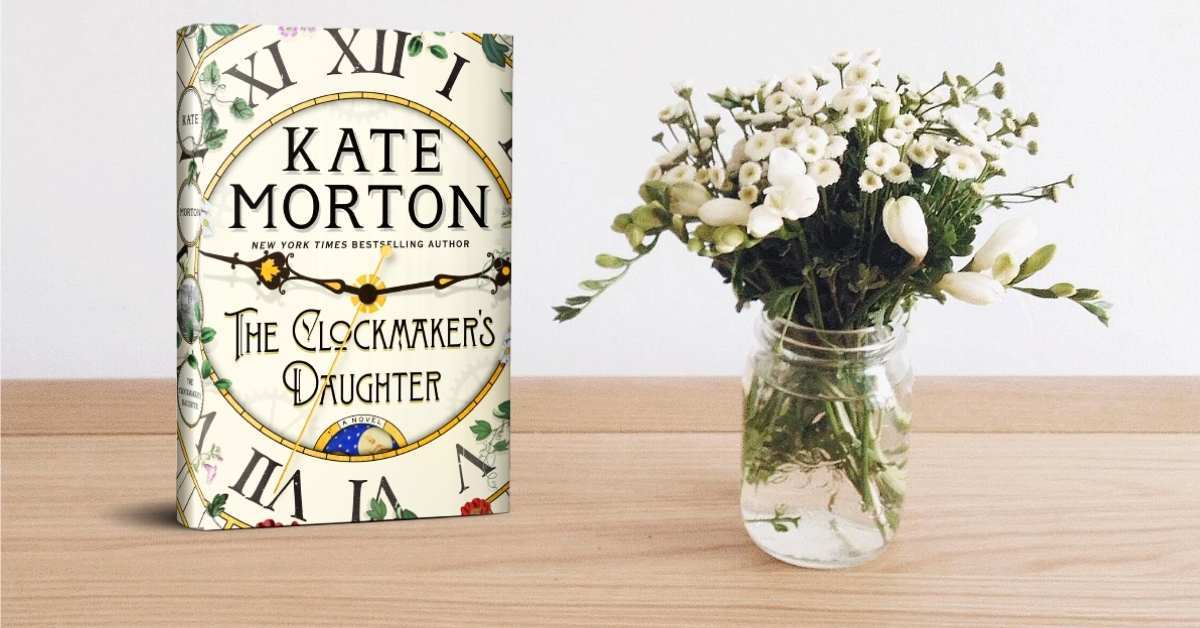The Clockmaker’s Daughter, by Kate Morton
Disclosure: This post may contain affiliate links, which means we may receive a commission if you click a link and purchase something that we have recommended. While clicking these links won't cost you any extra money, they will help us keep this site up and running! Please read our disclaimer for more details. Thank you for your support!

If you’re a fan of Kate Morton’s books, you know that two things are true of them: you wait for what feels like forever for the next one to come out and when it does, it stays with you for a very long time. The Clockmaker’s Daughter is no exception.
Morton’s latest novel is a haunting and richly detailed tome that spans more than 150 years, following the lives of several characters whose lives have intertwined because of their respective affiliations with Birchwood Manor, a sixteenth century country house in England that could arguably be considered the main character of the story.
Similar to her other books, The Clockmaker’s Daughter jumps back and forth between time periods, follows multiple interconnected stories, and hinges on one tragic decision made by someone in a crisis that has been kept secret for generations.
Elodie is the latest in a series of people who are drawn to the mysteries and almost magnetic force of Birchwood Manor. She works as an archivist in present-day London for the estate of James Stratton, a successful Victorian banker, and she discovers among his possessions a leather satchel containing a sketchbook, a photograph, and a letter. The sketchbook contains a drawing of a house that Elodie is certain she knows, a house from a story that her late mother told her as a child.
She sets out to discover how it is that James Stratton came into possession of these items, what their significance is, and why the house feels so familiar. Told from multiple perspectives, the novel then traces the stories of several other people impacted by the house, including Edward Radcliffe, the artist who purchased the house in 1862 and whose fiancée was killed during the robbery; his sister, Lucy; his model; Leonard, a student writing a dissertation on Edward; and Juliet, a young mother who evacuated to Birchwood Manor with her children during the war.
The story does not progress chronologically, but rather, from all angles at once, as though time stood still and everything that had happened at the house could just as easily have been yesterday as a century-and-a-half ago.
I found the fantasy element in this book much stronger than in any of Morton’s others, making it read almost like a fairy tale. (Not the type of fairy tale where princes save princesses, mind you. The other, darker kind.) The writing itself is almost magical; Morton has such a beautiful way with words. She transports her readers to a variety of settings, and one cannot help but feel like they are actually in Birchwood Manor, or sitting by the river, or running from a policeman through the streets of London.
Consider her description of the Thames: “The Thames here had a vastly different character to the wide, muddy tyrant that seethed through London. It was graceful and deft and remarkably light of heart. It skipped over stones and skimmed its banks, water so clear that one could see the reeds swaying deep down on her narrow bed. The river here was a she, he’d decided. For all its sunlit transparency, there were certain spots in which it was suddenly unfathomable.”
Morton weaves these beautiful metaphors in subtly, avoiding unnecessary elaborations. For example, about two characters who are reminiscing over a loved on they’ve lost, she writes, “They were two moons bound in orbit around his memory.”
Her character development is almost as impeccable as her rendering of the places, though some of the character were more clearly developed than others. I loved Edward—how forward thinking he was, how passionate, how completely absorbed in his craft. As a central figure to the story though, I felt like I didn’t get enough of him.
On the downside, as with many novels of this magnitude, the book took a while to grab my attention. I love Kate Morton’s books, so I know by now that the build-up is always worth it, but usually I’m enraptured within a few chapters. With The Clockmaker’s Daughter, I honestly didn’t start whipping through the pages until I was about seventy percent of the way through. That isn’t to say that the rest wasn’t well written; it was just that the mystery itself didn’t particularly grab at me until that point. From then on, I struggled to put it down.
Further, I felt like there were, perhaps, a few too many coincidences to be believable; also, I was left with many unanswered questions. It is the kind of book that makes me want to go back and read it again after I’ve finished it to see what details I might have missed.
Finally, without giving to much away, I have to mention that I am not really a fan of ghost stories, and the ghostly nature of The Clockmaker’s Daughter did, at times, make this book uncomfortable for me. Again, the quality of the writing and the grip of the narrative outweighed my discomfort, but I did find it somewhat unnerving.
I would recommend this book to fans of Kate Morton’s other works, or to those who enjoy novels such as Sarah’s Key or Those Who Save Us.
[Special thanks to Net Galley for the opportunity to review this special devotional. All opinions are my own.]
Want to get your copy?
The Clockmaker's Daughter will be available on October 9, 2018. Pre-order your copy from Amazon.
About Kate Morton
Kate Morton's five novels - The House at Riverton, The Forgotten Garden, The Distant Hours, The Secret Keeper and The Lake House - have all been New York Times bestsellers, Sunday Times bestsellers and international number 1 bestsellers; they are published in 34 languages, across 42 countries. Visit her website here.
I’m Sophie. I’m a writer, homeschooling mama, and recovering overachiever. I get by on good books, chocolate, and just enough sleep.
Introduce yourself in the comments below and tell me what kind of books you love to read.







